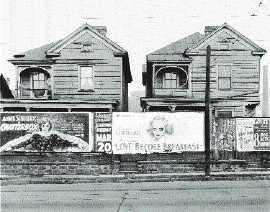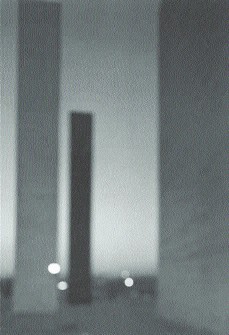Paris photo 2004 & Mois de la photo v Paříži
Last November Paris again became the centre of the world of photography, at the same time hosting both the Month of Photography and the Paris Photo fair. While the fair – thanks to the number of participating galleries and visitors, its accompanying events, excellent promotion and above all the diversity and quality of the presented photos – surpassed its main competitor, New York’s AIPAD, the circum- stances surrounding the Month of Photography once again reflected this festival’s gradual decline from fame as the most important photography festival in the world. Although the organisers of the Month of Photography emphasised the festival’s connection with the new (and unfortunately so far not very attractive) festivals in Berlin and Vienna on its posters and catalogue cover, this was really little more than a formal gesture, since there was minimal exchange of exhibits among the festivals and there were probably very few people who saw all three festivals within one month. Another factor that hardly increases the proclaimed worldliness of the Month of Photography is its stubborn insistence on French as the only language of the festival catalogue, while the organisers of Paris Photo have published all catalogue texts in French and English since the very beginning and last year’s Arles festival even published a separate English-language catalogue.Even more problematic, however, is the fact that in the past few years the Paris festival has tended each time to revolve around a single theme. Last year it was history, thus effectively excluding any extensive representation of contemporary photography, which is the most popular with audiences at any festival. What is more, the organisers opted for the easy way out and instead of trying to search out and present little known works from the history of photography, the programme featured mainly retrospectives of the most famous artists – Alfred Stieglitz, Walker Evans, Henri Cartier-Bresson, Robert Capa, Mario Giacomelli, Robert Doisneau and others. Many of these nevertheless were extremely meticulously prepared exhibits – most significantly the Musée d’Orsay’s impressive retrospective New York and Modern Art: Alfred Stieglitz and His Circle 1905-1930; the National Library’s Capa retrospective, dominated by his war reportage; and the reconstruction of the 1935 group exhibit of Alvarez Bravo, Cartier- Bresson and Evans at New York’s Julien Levy Gallery. However, even here regular visitors of photography festivals could find very little that they had not seen already. Placing a Bernd and Hilla Becher retrospective in the Centre Pompidou was probably the most noticeable example of the lack of inventiveness on the part of the Month of Photography organisers. I doubt that there was even one person among the festival visitors who wasn’t already familiar with their series of descriptive photographs of industrial architecture – photographs that, thanks to their constantly repeated exhibiting and publishing, are becoming as clichéd as the architecture they depict.
The largest festival exhibit, The Shadow of Time, held in the recently opened centre of photography located in the Jeu de Paume near the Louvre, had already been presented at London’s Tate Modern under the title Cruel and Tender: The Real in 20th-Century Photograph. Régis Durand’s rather inaccessible curatorial work, which combined the works’ chronological and thematic aspects, tried to show the development of 20th-century documentary and experimental photography (in many examples also film and video art) exclusively through famous works by Eugen Atget, André Kertész, Lászlo Moholy- Nagy, Claude Cahun, Raoul Hausmann, Dziga Vertov, Henri Cartier- Bresson (in whose case I was surprised by the technical imperfection of the original grey prints from the 1930s that set them clearly apart from his later high-contrast prints), Alexander Rodchenko (presenting, to my surprise, not original prints but posthumous enlargements), Robert Frank, the Bechers, Jeff Wall, Thomas Ruff, Nan Goldin, Bill Viola, Bruce Naumann and Cindy Sherman, while failing to show important works by Italian, Scandinavian, Czech or Japanese artists. The strongest parts of the exhibit were the screening of Nan Goldin’s The Ballad of Sexual Dependency and exquisite videos by Bill Viola.
A more revelatory part of the Month of Photography were the three exhibits held in the European House of Photography: the carefully selected presentation Photography and the Occult, showing various Hiroshi Sugimoto, Satelite Towers, 2002 bizarre shots of ghosts, spectres and levitating figures; Bruno Rosier’s witty comparisons, who photographed himself several decades apart in the same location in Manhattan, Lisbon and Cairo in the manner of people in old photographs; and the selection from the rich collection of the French Society of Photography featuring modernist nudes by František Drtikol. Twentieth-century Argentinean photography and Italian works from 1841-1941 also attracted large numbers of visitors, as did the exhibit of masterpieces from the collection of the Fnac department store. Current works could be seen primarily at foreign culture centres and smaller private galleries. Dramatic photojournalistic shots by Gilles Peress from Northern Ireland, Bosnia and Rwanda were presented at the Fait et Cause gallery. Our Polish neighbours were able to show several exhibits as part of the Polish season in France: a retrospective of the recently deceased Eustach Kossakowski, the Poland-Africa exhibit featuring shots from the African continent by several Polish photographers; the extensive Ex oriente lux exhibit presenting works by young artists, primarily Polish students at the Institute of Creative Photography at Silesian University in Opava (Grzegorz Dabrowski, Pawel Supernak, Grzegorz Klatka and others), showed typical aspects of life on the borders between Poland, Lithuania and Belarus. The Polish exhibits, however, were an exception to the Paris festival’s programme, which traditionally features works from Western Europe and the United States and this year even ignored contemporary photography from China and Russia, which is currently very popular. While in the 1980s the Month of Photography offered a representative overview of the latest trends in photography, its recent lack of ambition to leave safe waters has landed it in a significantly conservative position. A considerably larger number of contemporary photographs could be seen at the 8th annual Paris Photo, which between 11 and 14 Novem- ber 2004 attracted over 42,000 visitors to the large exhibit spaces underneath the Louvre. Some 105 exhibitors, including 92 galleries (among which was Prague’s Leica Gallery) and 13 photographic publishers, magazines, bookshops and antiquarian booksellers made their way past the selection jury. This year’s main guest was Switzerland, which was represented by eight galleries, each showing a single artist, and by an exhibit from the Fotomuzeum in Winterthur, which recently became the home for the collection of the Swiss Foundation for Photography. Visitors could admire works by Joel Sternfeld, Thomas Ruff, Robert Frank, Nobuyoshi Araki, Larry Clark, Tina Barney and other world-famous artists. An adjacent hall hosted screenings of Swiss films and videos on photographic themes.
Paris Photo’s commercial section showed examples from all eras in the evolution of photography. Masterpieces from the 19th century could be found at the stall of New York’s Hans P. Kraus and at that of Paris dealer Laurent Herschritt, who presented them lit by small lights in a dark room. Much more space, however, was dedicated to modernist and avant-garde works from the period between the two world wars, whose prices were some of the highest at the whole fair. The stall of Paris gallery 1900-2000 was dominated by original prints by Man Ray, Maurice Tabard, André Kertész, Pierre Molinier and Dora Maar; Vienna’s Galerie Johanes Faber presented works by mainstays of Austrian and Czech photography; Cologne’s Priska Pasquer gallery exhibited Albert Renger-Patzsch’s New Objectivity photos and Sander’s sociological portraits; while constructivist works by less knows Hungarian artists Marta Aczel, Imre Kinszki and Zoltán Seidner were offered by the Vintage Gallery from Budapest.
Most broadly represented, however, were contemporary artists. This is the main feature distinguishing Paris Photo from its New York competitor, the AIPAD fair, where older works prevail. Subjective documentary works by William Klein, Martin Parr and Nan Goldin were broadly represented, as were large-format shots of urban sceneries, industrial structures and destroyed landscapes by Gabriel Basilico, Simon Norfolk and Edward Burtynsky, exceptionally compelling colour portraits by Loretta Lux, and artists (Tina Barney and Elena Dorfman) who combine staged, portrait and documentary photography in an original manner. Traditional reportage and documentary photography were more represented by authors from the era from the 1930s to the 1960s than by contemporary works, even at the Magnum stall. Although several photographs at the fair were offered for over 100,000 euros, the prices of most of the prints did not exceed 2,000 euros and many were offered for even less than that, enabling acquisitions even by less well-off collectors. This was the case for the Leica Gallery Prague, where the best-selling works were still-lives by Luděk Vojtěchovský, while expensive prints by František Drtikol and Jaromír Funke were not sold. Many owners of the participating galleries complained that they sold less than in the previous years. This may be partially due to the weakened dollar, which discouraged a number of American collectors, for whom buying photographs priced in euros is becoming more expensive. Although Paris Photo presented a broad range of contemporary trends, important artists and various classic and digital photographs, the most famous artists – artists such as Andreas Gursky, Cindy Sherman, Jeff Wall, Rineke Dijkstra or Sam Taylor-Wood, who do not view themselves as photographers but as artists using photography and whose works often sell for hundreds of thousands of dollars – were not represented at this fair. The galleries that represent them prefer art fairs featuring photographs alongside paintings, sculptures and videos, such as Art Basel, Art Basel/Miami Beach or FIAC in Paris.
#5 Borders of Documentary
Archive
- #45 hypertension
- #44 empathy
- #43 collecting
- #42 food
- #41 postdigital photography
- #40 earthlings
- #39 delight, pain
- #38 death, when you think about it
- #37 uneven ground
- #36 new utopias
- #35 living with humans
- #34 archaeology of euphoria
- #33 investigation
- #32 Non-work
- #31 Body
- #30 Eye In The Sky
- #29 Contemplation
- #28 Cultura / Natura
- #27 Cars
- #26 Documentary Strategies
- #25 Popular Music
- #24 Seeing Is Believing
- #23 Artificial Worlds
- #22 Image and Text
- #21 On Photography
- #20 Public Art
- #19 Film
- #18 80'
- #17 Amateur Photography
- #16 Photography and Painting
- #15 Prague
- #14 Commerce
- #13 Family
- #12 Reconstruction
- #11 Performance
- #10 Eroticon
- #9 Architecture
- #8 Landscape
- #7 New Staged Photography
- #6 The Recycle Image
- #5 Borders Of Documentary
- #4 Intimacy
- #3 Transforming Of Symbol
- #2 Collective Authorship
- #1 Face



